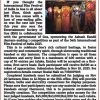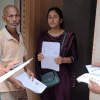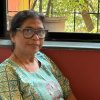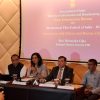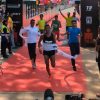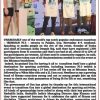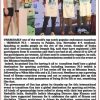Goa is abuzz with excitement as vintage bike and car owners, users, collectors and fans are decking […]
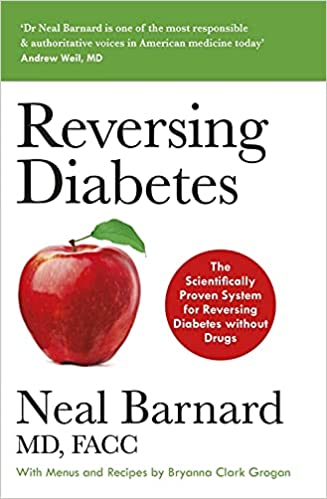
EATING TO WIN OVER DIABETES!
Feb 11- Feb 17 2023 February 10, 2023By Tara Narayan
Eating is Fun / Eating is Yuck!
A variety health food column
THE older I get the more I learn that what we eat is really what we suffer from in a myriad ways. This is being increasingly said by experts more qualified than me (mine is only a lifetime’s experience in ill-health and an inability to make the sweeping changes required in dietary habits). We think and worry about food all the time and what to put on the table, but food for life should be the least of our problems if we eat enough greens, fruit, a handful of a variety of cooked grain…yet all around me I see how we (including me) are driven by feasts of processed, cooked, transformed foods out of plastics to please the conditioned palate. Be it vegetarian, non-vegetarian or both.
We just don’t know how to eat. So much of our diseases are the result of faulty eating from childhood and so we reap the diseases we suffer from and grumble about all the time. Sometimes old books are worth re-visiting and I consider Neal Barnard (MD, FACC) book Reversing Diabetes’ the bible of diabetes, absolutely the last word (just as I consider Dr Dean Ornish the last word on fool-proof ways to reverse heart disease). I have been re-reading the fascinating story of diabetes courtesy Dr Neal Barnard’s bookReversing Diabetes.’ Hypertension, diabetes and heart disease are conditions we fear the most en route to saying goodbye cruel earth and these conditions proliferate happily is many of our urban, educated societies…today, who doesn’t suffer from BP, diabetes or heart disease as the years of bad eating and drinking catch up with us? Then begin the rounds with doctors and specialists who will only see us as an organ here and there and never the whole body beautiful in toto and how every bit has a bearing on the other as if cheek by jowl!
How Doctors
Diagnose Diabetes
Doctors diagnose diabetes if:
Your blood glucose level is 126 mg/dl (7.0mmol/l after an 8-hour fast.
Your blood glucose is 200 mg/dl (11.1 mmol/l) or higher after a 2-hour glucose tolerance test. This is a test in which you drink a syrup containing 75 grams of glucose, and your blood glucose value is measured.
Your A1C blood test is 6.5 or higher. A1C is a test that reflects your blood sugar control over the preceding 3 months or so, unlike a blood glucose test, which will tend to rise and fall from minute to minute under the influence of foods, physical activity, medications, stress and other factors. What the A1C test actually measures is how much glucose has entered your red blood cells and become stuck to haemoglobin. If you have had a lot of glucose in your blood, a fair amount of it gets into your cells and sticks to your haemoglobin.
NOWADAYS there’re lots of books educating us about diabetes and how to reverse it…what happens when our pancreas goes for a toss, assaulted as it with the kind of non-food we consume with healthy or sick appetites morning, noon and night. Read Reversing Diabetes’ if you want a solution to diabetes (he is the famous author of several bestsellers to his credit, all showing us the way to clean up our lifestyle eating). He is also the founder and president of the Physicians Committee for Responsible Medicine in the US of A, a frequent lecturer around the world and adjunct professor of medicine at the George Washington University School of Medicine. He has done some tremendous research on a disease which haunts most of us around the world as diabetes is the beginning of many a premature death. With discipline and will-power we can reverse diabetes, the disease of excessive refined carbohydrate consumption or should I say overeating, obesity and the toll it takes on the pancreas, with blood sugar rising and going haywire when glucose doesn’t make it into the cells for nourishment and metabolism to happen…our eyesight and nerve symptoms to indicate problems with the kidneys and heart. In his book Dr Barnard says it is often possible to improve insulin sensitivity and tackle type 2 diabetes before all the damage happens elsewhere with failing or compromised health parameters. HE offers a healthful vegan diet with recipes! It’s an easy-to-follow do it guide and there’re all kinds of fascinating and interesting titbits and advice on supplements, troubleshooting tips, much, much more useful information about how to put the problems of high blood sugar behind us. There are magic foods which also work as appetite controllers….but first we want reduce excess weight issues and we can do this eating the right amount of food at the right time. Maybe we know much of it, about eating complex carbohydrates, whole grains…no refined flours with their high glycemic index, it all goes along with shunning refined oils, minimising salt intake and so on. In America there is so much information out for public education that the marketplace even offers you say for example Twizzlers Strawberry twisters, that is low-fat candy. But as the good doctor points out, “it is basically a sugary concoction containing nothing that your body even remotely needs. Sugar is nowhere near as high in calories as fat, but it still provides more calories than you need.” So we need to cut down on calories and eat better quality calories which burn long, at least three or more hours after a meal – this is what gives an extra edge for losing weight to beat diabetes. Hey, I know a Goan doctor who eats two red amaranth (nachne/ragi) roti for breakfast, another two for lunch and two more for dinner – no rice and wheat food – and he is now pretty neatly trim and slim, enjoys super health status. Which means of course that the alkaline millet roti are healthier to eat (as long as we don’t load them with too much inputs of fat, salty spicing, et al …to make them over flavorful). The key to abolishing diabetes is oftentimes just observing appetite control by eating complex carbohydrate and fibre rich small meals. Generally speaking the advice is to avoid animal products, keeping oils to a minimum, and favouring low-GI foods. There is evidence that these steps reduce your risk, did you know that people who avoid fatty foods tend to have less cataract risk? All this and much more. I think this book by Dr Neal Barnard is an invaluable book for all time and everyone interested in harvesting better health should read it. Says Dr Barnard, “No matter how healthy you get, you should still keep an eye on your glucose, AIC, and cholesterol; blood pressure, weight, eyes; and feet. But I hope as you tune up your diet and lifestyle, that it’s all you will be doing – just confirming that all is just as it should be.” Also, “Exercise is important, but it cannot begin to take the place of diet changes.” (Sigh) the more I read this book the more my follies of the past catch up with me! Most of us are in search of the perfect diet in a bloody imperfect world filled with absurd and traumatic “situations” which are sometimes just excuses, but oftentimes also very real as time flies by. Needless to say the book is full of insightful case studies and useful information you can do with if diabetes or insulin resistance is bugging you (like it is me). If you’re suffering from diabetic neuropathy the good doctor recommends alpha-lipoic acid, gamma-linolenic acid, carnitine by way of supplements but consult your doctor on how much to take. Reversing Diabetes’ offers a scientifically proven system for reversing diabetes without drugs, doctors need to read it if they’re treating patients for diabetes. It also comes with some tantalizing menus and recipes by Bryanna Clark Grogan, the book was first published in 2006 by Sheldon Press.
Excerpted from `Reversing
Diabetes’ by Neal Barnard, MD, FACC…
I LEARNED about animal fat as a child growing up in North Dakota. Some mornings, my mother cooked bacon for my four siblings and me. When it was done, she put the hot strips on paper towels to drain. She then carefully picked up the frying pan and poured the hot grease into a jar to save it. Now, she did not store the jar of bacon grease in the refrigerator; she simply put it in the cupboard. She knew that as it cooled, it would turn into a waxy solid. The next day, she spooned some of the bacon grease into a pan and fried eggs in it. With that sort of diet, it is perhaps remarkable that any of her children lived to adulthood, but that is the way we ate until we learned better.
The fact that bacon grease is solid at room temperature is a sign that it is loaded with saturated fat, which you can think of as “bad” fat, because it raises your cholesterol level.
All fats are mixtures. Beef fat, for example, is about half saturated fat, with the rest being a mixture of various unsaturated fats. Chicken fat is about 30 per cent saturated fat. Fish vary from about 15 to 30 per cent saturated fat. Vegetable oils are much lower in saturated fat, except for the tropical oils. Coconut, palm, and palm kernel oil are all high in saturated fat.
Some food companies alter vegetable oils through a process called hydrogenation, which makes them similar to saturated fats. The resulting fats, called trans fats or partially hydrogenated fats, are solid and have a long shelf life. Unfortunately, their effect on your cholesterol level is similar to that of butter or lard. They are sometimes used to in restaurant fryers and in snack foods. When you see the words partially hydrogenated vegetable oil on a food label, it’s a good idea to move along to a healthier choice.
You can see why Dr Ornish decided to use a vegetarian diet in a program of healthy lifestyle changes Plant foods have essentially no cholesterol and no animal fat. He also kept vegetable oils to a minimum.
The results were remarkable. Among the vegetarians, chest pain rapidly melted away. The average person’s LDL ((“bad”) cholesterol fell by about 40 per cent. After a year, each participant had an angiogram – a special x-ray that shows blockages in the arteries of the heart – and Dr Ornish compared the results with those of the same kind of test done at the beginning of the study. The results were amazing: The blockages in the coronary arteries – the arteries that nourish the heart muscle itself – were actually starting to shrink the arteries were opening again. The effect was so pronounced that that the difference could be clearly sees on the angiograms of 82 per cent of patients after the first year – all with no heart bypasses, no angioplasties, and no even cholesterol-lowering drugs.
